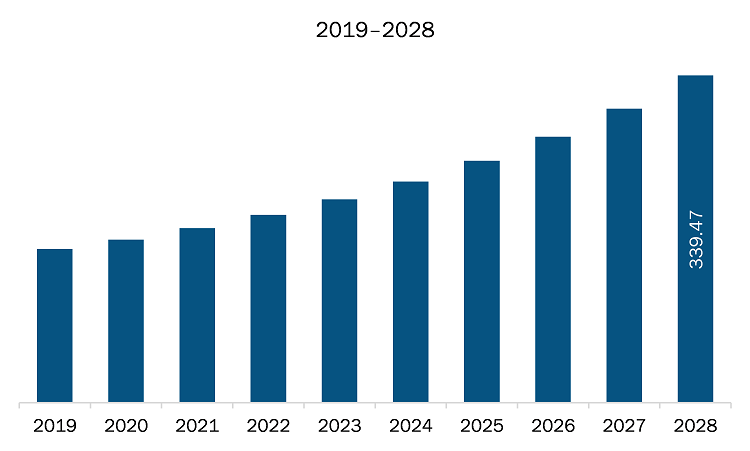Page Updated:
Oct 2021
The smart pest monitoring management system market in APAC is expected to grow from US$ 181.03 million in 2021 to US$ 339.47 million by 2028; it is estimated to grow at a CAGR of 9.4% from 2021 to 2028.
Japan, China, and India are major economies in APAC. Growing rates of urbanization and middle-class population drive pest control demand in residential applications is the major factor driving the growth of the APAC smart pest monitoring management system market. The increasing popularity of smart pest control solutions, along with the growing urbanization in developing markets and the advent of megacities, is creating a massive opportunity for the smart pest monitoring management system market. Countries such as China and India are among the key markets targeted by pest control service providers and pesticide suppliers, owing to the presence of high population density and a large middle-class population that is adopting pest control services. The residential sector witnessed a huge demand for smart pest monitoring management systems to efficiently handle the problem of the increasing number of bed bugs, mosquitoes, cockroaches, and termites. Moreover, insecticide aerosols are usually suggested to be applied across small buildings or nearby areas. The most common forms of pests found in the residential areas include cockroaches, lice, rodents, termites, ticks, bed bugs, and wildlife pests, such as opossums, raccoons, gophers, and moles. The presence of these pests forces the population to perform pest control in the house from time to time. The pest control solutions used for residential areas include chemical spraying, aerosols, and baits. In cases of high levels of fumigation and infestation in the residential sector the use of smart pest control method is considered to be more efficient. The residential construction sector has started gaining momentum in recent years after weak growth in the past years. This can be attributed to the surging global population and increasing demand for efficient pest control methods. Thus, the growth in residential construction is likely to surge the need for efficient smart pest control, thereby boosting the demand for smart pest monitoring management systems in the coming years. Thus, the increasing residential sector is creating a massive growth opportunity for the smart pest monitoring management system market, which is further anticipated to drive the market in APAC.
According to the Organization for Economic Co-operation and Development (OECD), the pandemic has affected major economies of APAC.Due to this outbreak, negative implications such as supply chain disruptions and labor shortages have severely impacted digital agriculture. Nevertheless, the COVID-19 impact for in the short term, would affect the growth of smart pest monitoring management system market negatively and the adoption rate of smart pest control method and solutions would be relatively slower due to economic slowdown and inflation.

- This FREE sample will include data analysis, ranging from market trends to estimates and forecasts.
APAC Smart Pest Monitoring Management System Market Segmentation
APAC Smart Pest Monitoring Management System Market – By Component
- Hardware
- Software and Services
APAC Smart Pest Monitoring Management System Market – By End-User
- Commercial
- Residential
- Agriculture
- Industrial
APAC Smart Pest Monitoring Management System Market– By Country
- China
- Japan
- South Korea
- India
- Australia
- Rest of APAC
APAC Smart Pest Monitoring Management System Market-Companies Mentioned
- Anticimex
- Bayer AG
- Bell Labs
- Corteva
- EFOS d.o.o
- Pelsis Group Ltd
- PestWest USA
- Rentokil Initial plc
- VM Products
Asia Pacific Smart Pest Monitoring Management System Report Scope
| Report Attribute | Details |
|---|---|
| Market size in 2021 | US$ 181.03 Million |
| Market Size by 2028 | US$ 339.47 Million |
| CAGR (2021 - 2028) | 9.4% |
| Historical Data | 2019-2020 |
| Forecast period | 2022-2028 |
| Segments Covered |
By Component
|
| Regions and Countries Covered |
Asia-Pacific
|
| Market leaders and key company profiles |
|
- Historical Analysis (2 Years), Base Year, Forecast (7 Years) with CAGR
- PEST and SWOT Analysis
- Market Size Value / Volume - Regional, Country
- Industry and Competitive Landscape
- Excel Dataset
Recent Reports
Testimonials
Reason to Buy
- Informed Decision-Making
- Understanding Market Dynamics
- Competitive Analysis
- Identifying Emerging Markets
- Customer Insights
- Market Forecasts
- Risk Mitigation
- Boosting Operational Efficiency
- Strategic Planning
- Investment Justification
- Tracking Industry Innovations
- Aligning with Regulatory Trends
Our Clients






























Sales Assistance
US: +1-646-491-9876
UK: +44-20-8125-4005
Email: sales@theinsightpartners.com
Chat with us

87-673-9708

ISO 9001:2015




 Get Free Sample For
Get Free Sample For